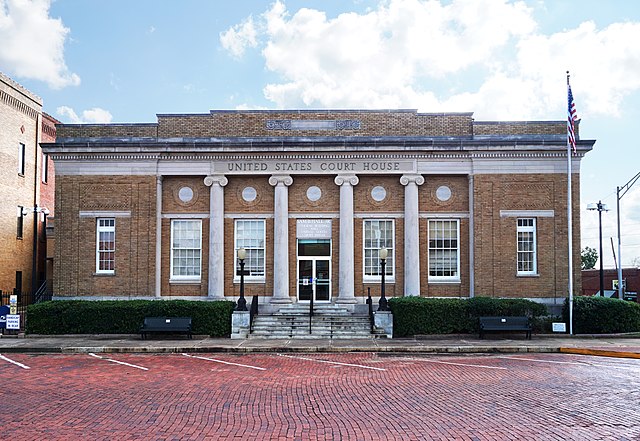Samuel Blakeley Hall Jr. was an American lawyer, politician, and judge. He was a member of the United States House of Representatives from Texas's 1st congressional district from 1976 to 1985 and a United States district judge of the United States District Court for the Eastern District of Texas from 1985 until his death in 1994.
Sam B. Hall Jr.
The Sam B. Hall Jr. U.S. Courthouse on Whetstone Square in Marshall, Texas. The building was originally constructed in the 1920s as a Post Office, but the Post Office moved to a newer facility in the 1960s.
Marshall is a city in the U.S. state of Texas. It is the county seat of Harrison County and a cultural and educational center of the Ark-La-Tex region. At the 2020 U.S. census, the population of Marshall was 23,392; The population of the Greater Marshall area, comprising all of Harrison County, was 65,631 in 2010, and 66,726 in 2018.
Clockwise: Old Courthouse, Starr Home, Hotel Marshall, ETBU, Depot, Wiley, Ginnocho, First United Methodist
The Wyalucing plantation was the childhood home of Lucy Holcombe Pickens, the only woman whose image was used on Confederate currency. It housed the office of the Trans-Mississippi Postal Department of the Confederacy. In 1880, freedmen bought the plantation and used it for the campus of Bishop College, founded for black students. The main house was used as the president's house.
A former slave displays a horn in 1939 that was formerly used by planters to call slaves on the outskirts of Marshall. Many freedmen moved to Marshall from rural areas during Reconstruction, creating their own community and seeking the chance to live away from the supervision of whites. After Union troops departed at the end of Reconstruction, Democrats formed the White Citizens Party, establishing an insurgent militia dedicated to white supremacy.
The community has developed in and around Whetstone Square, shown here in 1939. White guests stayed at the Capitol Hotel, right, and the taller Hotel Marshall directly behind it. In the 1960s, the Harrison County Courthouse, center, was the site of the first sit-ins in Texas by the civil rights movement.






